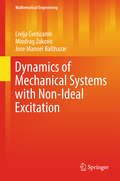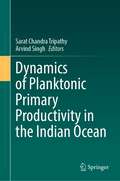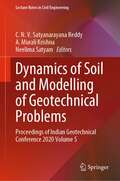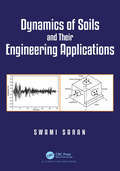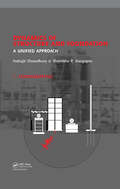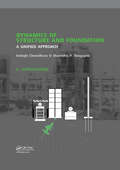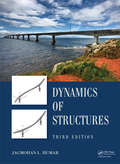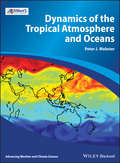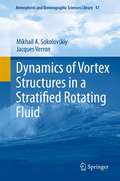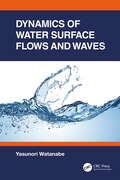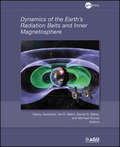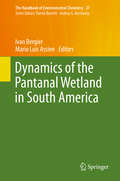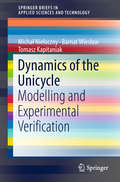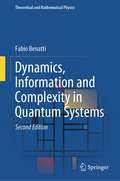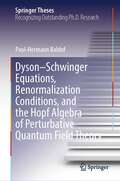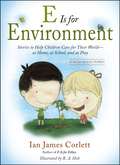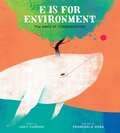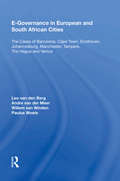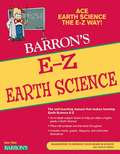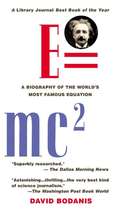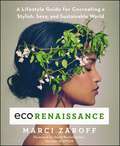- Table View
- List View
Dynamics of Mechanical Systems with Non-Ideal Excitation
by Livija Cveticanin Miodrag Zukovic Jose Manoel BalthazarIn this book the dynamics of the non-ideal oscillatory system, in which the excitation is influenced by the response of the oscillator, is presented. Linear and nonlinear oscillators with one or more degrees of freedom interacting with one or more energy sources are treated. This concerns for example oscillating systems excited by a deformed elastic connection, systems excited by an unbalanced rotating mass, systems of parametrically excited oscillator and an energy source, frictionally self-excited oscillator and an energy source, energy harvesting system, portal frame – non-ideal source system, non-ideal rotor system, planar mechanism – non-ideal source interaction. For the systems the regular and irregular motions are tested. The effect of self-synchronization, chaos and methods for suppressing chaos in non-ideal systems are considered. In the book various types of motion control are suggested. The most important property of the non-ideal system connected with the jump-like transition from a resonant state to a non-resonant one is discussed. The so called ‘Sommerfeld effect’, resonant unstable state and jumping of the system into a new stable state of motion above the resonant region is explained. A mathematical model of the system is solved analytically and numerically. Approximate analytical solving procedures are developed. Besides, simulation of the motion of the non-ideal system is presented. The obtained results are compared with those for the ideal case. A significant difference is evident. The book aims to present the established results and to expand the literature in non-ideal vibrating systems. A further intention of the book is to give predictions of the effects for a system where the interaction between an oscillator and the energy source exist. The book is targeted at engineers and technicians dealing with the problem of source-machine system, but is also written for PhD students and researchers interested in non-linear and non-ideal problems.
Dynamics of Planktonic Primary Productivity in the Indian Ocean
by Arvind Singh Sarat Chandra TripathyThis volume compiles recent research on phytoplankton primary productivity (PP) in the Indian Ocean to provide an understanding and consolidation of the driving mechanisms of PP variability in diverse oceanic ecosystems globally. The book aims to facilitate a holistic overview of the research carried out in this field in various oceanic realms such as Indian coastal and oceanic waters (estuaries, coastal waters, Bay of Bengal, Arabian Sea, Indian Ocean). The contents of this book also address the United Nations sustainable development goals i.e., SDG 13 (Climate Action) and SDG 14 (Life below Water), with a focus on the impacts of climate change oceanic ecosystems. The book can serve as a comprehensive baseline of information for researchers studying planktonic primary productivity and biogeochemistry-related research in the above-mentioned marine ecosystems and other global oceans. It is intended to attract the attention of researchers, professionals, undergraduate and graduate oceanography students, and policy makers in the field of marine sciences.
Dynamics of Soil and Modelling of Geotechnical Problems: Proceedings of Indian Geotechnical Conference 2020 Volume 5 (Lecture Notes in Civil Engineering #186)
by A. Murali Krishna C. N. V. Satyanarayana Reddy Neelima SatyamThis book provides information on the latest technological developments taking place in Geotechnical engineering, pertaining to Soil Dynamics and Modelling of Geotechnical Problems. The book is useful for the academicians and working professionals with coverage of both theoretical and practical aspects of Dynamics of Soil and Modelling studies on Geotechnical problems based on research findings and site specific inputs. The book serves as a useful reference resource for graduate and postgraduate students of civil engineering and contents of the book are helpful to the postgraduate students and research scholars in carrying out the research.
Dynamics of Soils and Their Engineering Applications
by Swami SaranThe book offers systematic dynamic analysis of soils and their engineering applications, including machine foundations, and aims to develop a clear understanding of the subject. It comprises sixteen chapters. Chapter 1 introduces the reader to the various problems in soil dynamics. In Chapter 2, concepts of theory of vibrations are discussed along with their applications in designing Vibration Absorbers and Pickups. Wave propagation in elastic medium including wave refraction in layered medium is covered in Chapter 3. Chapter 4 deals with the procedure of determining dynamic properties of soils using various laboratory and field tests. Dynamic earth pressures in retaining walls and dynamic bearing capacity of footings are dealt with in Chapters 5 and 6 respectively. Chapters 7and 8 respectively deal with dynamic behavior of pile foundations and slopes. Causes of liquefaction of soils and prediction of liquefaction potential have been discussed in Chapter 9. In Chapter 10, the procedure of estimating the unbalanced forces in various types of machines are covered. Chapters 11, 12 and 13 deal with the analysis and design of foundations of reciprocating machine, hammer, and turbo-generators respectively. In Chapter 14, problems of vibration isolation and screening are dealt with. Chapter 15 discusses the analysis and design of reinforced earth wall located in seismic areas. A new concept of a conventional rigid retaining wall having reinforced backfill is presented in Chapter 16, giving complete analysis and design procedure considering seismic forces.
Dynamics of Structure and Foundation - A Unified Approach: 1. Fundamentals
by Indrajit Chowdhury Shambhu P. DasguptaDesigned to provide engineers with quick access to current and practical information on the dynamics of structure and foundation, this unique work, consisting of two separately available volumes, serves as a complete reference, especially for those involved with earthquake or dynamic analysis, or the design of machine foundations in the oil, gas, a
Dynamics of Structure and Foundation - A Unified Approach: 2. Applications
by Indrajit Chowdhury Shambhu P. DasguptaDesigned to provide engineers with quick access to current and practical information on the dynamics of structure and foundation, this 2-volume reference work is intended for engineers involved with earthquake or dynamic analysis, or the design of machine foundations in the oil, gas, and energy sector. Whereas Volume 1 (ISBN 9780415471459
Dynamics of Structures
by J. HumarThis major textbook provides comprehensive coverage of the analytical tools required to determine the dynamic response of structures. The topics covered include: formulation of the equations of motion for single- as well as multi-degree-of-freedom discrete systems using the principles of both vector mechanics and analytical mechanics; free vibratio
Dynamics of The Tropical Atmosphere and Oceans (Advancing Weather and Climate Science)
by Peter J. WebsterThis book presents a unique and comprehensive view of the fundamental dynamical and thermodynamic principles underlying the large circulations of the coupled ocean-atmosphere system Dynamics of The Tropical Atmosphere and Oceans provides a detailed description of macroscale tropical circulation systems such as the monsoon, the Hadley and Walker Circulations, El Niño, and the tropical ocean warm pool. These macroscale circulations interact with a myriad of higher frequency systems, ranging from convective cloud systems to migrating equatorial waves that attend the low-frequency background flow. Towards understanding and predicting these circulation systems. A comprehensive overview of the dynamics and thermodynamics of large-scale tropical atmosphere and oceans is presented using both a “reductionist” and “holistic” perspectives of the coupled tropical system. The reductionist perspective provides a detailed description of the individual elements of the ocean and atmospheric circulations. The physical nature of each component of the tropical circulation such as the Hadley and Walker circulations, the monsoon, the incursion of extratropical phenomena into the tropics, precipitation distributions, equatorial waves and disturbances described in detail. The holistic perspective provides a physical description of how the collection of the individual components produces the observed tropical weather and climate. How the collective tropical processes determine the tropical circulation and their role in global weather and climate is provided in a series of overlapping theoretical and modelling constructs. The structure of the book follows a graduated framework. Following a detailed description of tropical phenomenology, the reader is introduced to dynamical and thermodynamical constraints that guide the planetary climate and establish a critical role for the tropics. Equatorial wave theory is developed for simple and complex background flows, including the critical role played by moist processes. The manner in which the tropics and the extratropics interact is then described, followed by a discussion of the physics behind the subtropical and near-equatorial precipitation including arid regions. The El Niño phenomena and the monsoon circulations are discussed, including their covariance and predictability. Finally, the changing structure of the tropics is discussed in terms of the extent of the tropical ocean warm pool and its relationship to the intensity of global convection and climate change. Dynamics of the Tropical Atmosphere and Oceans is aimed at advanced undergraduate and early career graduate students. It also serves as an excellent general reference book for scientists interested in tropical circulations and their relationship with the broader climate system.
Dynamics of Vortex Structures in a Stratified Rotating Fluid
by Jacques Verron Mikhail A. SokolovskiyThis book presents an extensive analysis of the dynamics of discrete and distributed baroclinic vortices in a multi-layer fluid that characterizes the main features of the large and mesoscales dynamics of the atmosphere and the ocean. It widely covers the case of hetonic situations as well as the case of intrathermocline vortices that are familiar in oceanographic and of recognized importance for heat and mass transfers. Extensive typology of such baroclinic eddies is made and analysed with the help of theoretical development and numerical computations. As a whole it gives an overview and synthesis of all the many situations that can be encountered based on the long history of the theory of vortex motion and on many new situations. It gives a renewed insight on the extraordinary richness of vortex dynamics and open the way for new theoretical, observational and experimental advances. This volume is of interest to experts in physical oceanography, meteorology, hydrodynamics, dynamic systems, involved in theoretical, experimental and applied research and lecturers, post-graduate students, and students in these fields.
Dynamics of Water Surface Flows and Waves
by Yasunori WatanabeDynamics of Water Surface Flows and Waves provides theoretical descriptions of the whole life of water surface waves through their birth, propagation, evolution and finally breaking. While initial capillary waves are created via instability at air-water interfaces, potential wave theories adequately describe interactions of waves with current, bathymetry and structure. In the final breaking stage, potential fluid motions in the waves rapidly evolve into vortical turbulent flows that disturb the surfaces, resulting in entrainment of air-bubbles and ejection of sea spray in bursting bubbles floating on the surface. All theories and analytical methods required to understand the series of wave processes, over diverse areas of subjects, including turbulence, diffusion, vortex and capillary dynamics, shallow water approach, and stability analysis, as well as the conventional potential wave theory, are comprehensively covered in this book. All of the mathematical formulas are consistently developed from theorems and linked with physics, which provides theoretical understanding and further interest in wave dynamics. This is an ideal graduate-level textbook or reference for engineers and researchers in the fields of fluid and wave mechanics, coastal and ocean engineering.
Dynamics of the Earth
by S. V. Ferronsky V. I. FerronskyIn their search for solutions to problems concerning the dynamics of the Earth as a self-gravitating body, the authors have applied the fundamentals found in their book "Jacobi Dynamics" (1987, Reidel). First, satellite observations have shown that the Earth does not remain in hydrostatic equilibrium, which forms the physical basis of modern geodynamics. Secondly, satellite data have established a relationship between the planet's polar moment of inertia and the potential of the Earth's outer force field, which proves the most basic point of Jacobi dynamics. This allowed the authors to revise their derivation of the classical virial theorem, introducing the concept of a volumetric force and volumetric moment, and so to obtain a generalized virial theorem in the form of Jacobi's equation. The main dynamical effects are: the kinetic energy of oscillation of the interacting particles, which explains the physical meaning and nature of gravitational forces; separation of shells of a self-gravitating body with respect to its mass density; differences in angular velocities of the shell's rotation; continuity in variance of the potential of the outer gravitational force field, together with reductions in the envelope of the interacting masses (volumetric center of gravity); the nature of Earth, Moon and satellite precession; the nature and generating mechanism of the planet's electromagnetic field; the common nature of gravitational and electromagnetic energy, and other related issues. The work is a logical continuation of the book "Jacobi Dynamics" and is intended for researchers, teachers and students engaged in theoretical and experimental research in various branches of astronomy, geophysics, planetology and cosmogony, and for students of celestial, statistical, quantum and relativistic mechanics and hydrodynamics.
Dynamics of the Earth System: Contributions from Scientific Ocean Drilling (Society of Earth Scientists Series)
by Dhananjai K. Pandey M. Ravichandran Nisha NairThis book highlights Indian scientific endeavours and contributions to answering the vast multitude of questions posed by our changing environment. The International Ocean Discovery Program (IODP) explores Earth’s history and dynamics using deep ocean drilling platforms to recover the data locked inside seafloor sediments and rocks. Since 2009, Indian scientists have been actively engaged in these expeditions. Scientists from various Earth Science disciplines have seized this opportunity to offer their expertise in order to help unravel the mysteries of the past – by delving deep into the valuable sedimentary records of our oceans. This book presents a compilation of some of their most important findings to motivate and encourage young minds for their enhanced role in the cutting edge science of ocean drilling.
Dynamics of the Earth's Radiation Belts and Inner Magnetosphere, 1st Edition
by D. N. Baker Danny Summers I. R. Mann M. G. SchulzPublished by the American Geophysical Union as part of the Geophysical Monograph Series, Volume 199.Dynamics of the Earth's Radiation Belts and Inner Magnetosphere draws together current knowledge of the radiation belts prior to the launch of Radiation Belt Storm Probes (RPSP) and other imminent space missions, making this volume timely and unique. The volume will serve as a useful benchmark at this exciting and pivotal period in radiation belt research in advance of the new discoveries that the RPSP mission will surely bring. Highlights include the following: a review of the current state of the art of radiation belt science; a complete and up-to-date account of the wave-particle interactions that control the dynamical acceleration and loss processes of particles in the Earth's radiation belts and inner magnetosphere; a discussion emphasizing the importance of the cross-energy coupling of the particle populations of the radiation belts, ring current, and plasmasphere in controlling the dynamics of the inner magnetosphere; an outline of the design and operation of future satellite missions whose objectives are to discover the dominant physical processes that control the dynamics of the Earth's radiation belts and to advance our level of understanding of radiation belt dynamics ideally to the point of predictability; and an examination of the current state of knowledge of Earth's radiation belts from past and current spacecraft missions to the inner magnetosphere. Dynamics of the Earth's Radiation Belts and Inner Magnetosphere will be a useful reference work for the specialist researcher, the student, and the general reader. In addition, the volume could be used as a supplementary text in any graduate-level course in space physics in which radiation belt physics is featured.
Dynamics of the Pantanal Wetland in South America
by Ivan Bergier Mario Luis AssineThis book provides readers with in-depth insights into the changes in the Pantanal wetland from its formation to the actual and likely future states. It reveals that today's Pantanal is an evolutionary consequence of geological, ecological and, more recently, man-made events taking place at distinct space-time intervals. Topics include geotectonics and sun-earth interactions, which largely dictate the rate of drastic changes that eventually disrupt ecological stability and radically rebuild the regional landscape. Furthermore, the biota-climate system is discussed as a major driver reshaping the ecohydrology functioning of the landscape on an intermediate timescale. Also covered are major changes in the landscape ecohydrology and biodiversity due to recent land-use and climate changes induced by humankind in the Anthropocene. The ability to recognize how those temporal scales impact the Pantanal wetland provides the opportunity for wise management approaches and the sustainable development of the region.
Dynamics of the Unicycle: Modelling And Experimental Verification (SpringerBriefs in Applied Sciences and Technology)
by Tomasz Kapitaniak Michał Niełaczny Barnat WiesławThis book presents a three-dimensional model of the complete unicycle–unicyclist system. A unicycle with a unicyclist on it represents a very complex system. It combines Mechanics, Biomechanics and Control Theory into the system, and is impressive in both its simplicity and improbability. Even more amazing is the fact that most unicyclists don’t know that what they’re doing is, according to science, impossible – just like bumblebees theoretically shouldn’t be able to fly. This book is devoted to the problem of modeling and controlling a 3D dynamical system consisting of a single-wheeled vehicle, namely a unicycle and the cyclist (unicyclist) riding it. The equations of motion are derived with the aid of the rarely used Boltzmann–Hamel Equations in Matrix Form, which are based on quasi-velocities. The Matrix Form allows Hamel coefficients to be automatically generated, and eliminates all the difficulties associated with determining these quantities. The equations of motion are solved by means of Wolfram Mathematica. To more faithfully represent the unicyclist as part of the model, the model is extended according to the main principles of biomechanics. The impact of the pneumatic tire is investigated using the Pacejka Magic Formula model including experimental determination of the stiffness coefficient. The aim of control is to maintain the unicycle–unicyclist system in an unstable equilibrium around a given angular position. The control system, based on LQ Regulator, is applied in Wolfram Mathematica. Lastly, experimental validation, 3D motion capture using software OptiTrack – Motive:Body and high-speed cameras are employed to test the model’s legitimacy. The description of the unicycle–unicyclist system dynamical model, simulation results, and experimental validation are all presented in detail.
Dynamics, Information and Complexity in Quantum Systems (Theoretical and Mathematical Physics)
by Fabio BenattiThis second edition of Dynamics, Information and Complexity in Quantum Systems widens its scope by focussing more on the dynamics of quantum correlations and information in microscopic and mesoscopic systems, and their use for metrological and machine learning purposes. The book is divided into three parts: Part One: Classical Dynamical SystemsAddresses classical dynamical systems, classical dynamical entropy, and classical algorithmic complexity.Includes a survey of the theory of simple perceptrons and their storage capacity. Part Two: Quantum Dynamical SystemsFocuses on the dynamics of entanglement under dissipative dynamics and its metrological use in finite level quantum systems.Discusses the quantum fluctuation approach to large-scale mesoscopic systems and their emergent dynamics in quantum systems with infinitely many degrees of freedom.Introduces a model of quantum perceptron whose storage capacity is computed and compared with the classical one. Part Three: Quantum Dynamical Entropies and ComplexitiesDevoted to quantum dynamical entropies and algorithmic complexities. This book is meant for advanced students, young and senior researchers working in the fields of quantum statistical mechanics, quantum information, and quantum dynamical systems. It is self-contained, and the only prerequisites needed are a standard knowledge of statistical mechanics, quantum mechanics, and linear operators on Hilbert spaces.
Dyson–Schwinger Equations, Renormalization Conditions, and the Hopf Algebra of Perturbative Quantum Field Theory (Springer Theses)
by Paul-Hermann BaldufThis book offers a systematic introduction to the Hopf algebra of renormalization in quantum field theory, with a special focus on physical motivation, the role of Dyson–Schwinger equations, and the renormalization group. All necessary physical and mathematical constructions are reviewed and motivated in a self-contained introduction. The main part of the book concerns the interplay between Dyson–Schwinger equations (DSEs) and renormalization conditions. The book is explicit and consistent about whether a statement is true in general or only in particular renormalization schemes or approximations and about the dependence of quantities on regularization parameters or coupling constants. With over 600 references, the original literature is cited whenever possible and the book contains numerous references to other works discussing further details, generalizations, or alternative approaches. There are explicit examples and remarks to make the connection from the scalar fields at hand toQED and QCD. The book is primarily targeted at the mathematically oriented physicist who seeks a systematic conceptual overview of renormalization, Hopf algebra, and DSEs. These may be graduate students entering the field as well as practitioners seeking a self-contained account of the Hopf algebra construction. Conversely, the book also benefits the mathematician who is interested in the physical background of the exciting interplay between Hopf algebra, combinatorics and physics that is renormalization theory today.
E Is for Environment
by Ian James CorlettFrom the author of E IS FOR ETHICS, 26 stories with eco-friendly messages, accompanied by illustrations, discussion questions, and conservation tips.
E Is for Environment: The ABCs of Conservation
by Lucy CurranA is for Atmosphere, B is for Biodiversity, C is for Conservation, and so on in this delightful concept book that teaches young readers the ABCs of the natural world around us (and how to protect it).From jungles to recycling to wildlife preserves, each letter of the alphabet is represented by a word and image that reflects everything from the rainforest to the savannah to the depths of the ocean, as well as animal life across the continents. Readers will be inspired to join the movement to conserve species and find out how they can make a difference (because you're never too young to start saving the world!).
E-Governance in European and South African Cities: The Cases of Barcelona, Cape Town, Eindhoven, Johannesburg, Manchester, Tampere, The Hague and Venice (Euricur Ser. (european Institute For Comparative Urban Research) Ser.)
by Willem van Winden Leo van den Berg Andre van der Meer Paulus WoetsSince the late 1990s, city councils have become increasingly aware of the potential for information technologies (ICTs) to improve the management of cities and as an instrument for economic and social policy. This has resulted in a wave of urban ICT strategies and policies, such as the adoption of ICTs within the city administration itself, projects that facilitate access to ICTs by weaker social groups and policies to improve the urban electronic infrastructure. By comparing eight cities - Barcelona, Cape Town, Eindhoven, Johnnesburg, Manchester, Tampere, the Hague and Venice - this book examines a range of innovative urban e-governance strategies and develops a framework of analysis that permits a common approach. Throughout the book, a distinction is made between access policies (aimed at improving access to ICTs for all citizens), content policies (directed to improve the use of ICTs in the city administration and semi-public domains) and infrastructure policies (to improve the provision of broadband infrastructure). For each of the cities, e-strategies and policies are critically reviewed and compared. The book reveals that urban e-strategies have evolved from an internal and technology-centred orientation to a more outward-looking approach.
E-Waste Management: Challenges and Opportunities in India
by Varsha Bhagat-GangulyThis book offers an extensive review of e-waste management in India, the world’s third‑largest producer of waste from electrical and electronic equipment. With a focus on the evolution of legalframeworks in India and the world, it presents impacts and outcomes; challenges and opportunities; and management strategies and practices to deal with e-waste. First of its kind, the book examines relevant concepts and issues from across 15 disciplines and six areas of policy making and will serve as a comprehensive knowledge base on electronic waste in India. It links key themes to the global context of Sustainable Development Goals and explores the convergence with technological, infrastructural, and social initiatives in e-waste management. A range of topics are discussed, such as resource efficiency policies; circular economy; toxicity; technicalities and complexities of e-waste management including role of the informal sector and need for recognising social and human costs in policy making. The book deals with the role of statistics; legal trends and reforms; linkages with green Agenda 2030 and UN initiatives; implementation of Extended Producer Responsibility (EPR); environmental factors; business prospects; consequences on human health; Life Cycle Impact Assessment; the ‘six Rs’ (Responsible use, Repair, Refurbish, Recycle, Recover and Reuse); recycling practices and problems, material flow and informal sector in trade value chain; fostering partnership between formal-informal sectors; safe disposal; alternatives to landfilling; role of jurisprudence and regulatory bodies; and education and awareness. It also includes a survey of pan-India initiatives and trajectories of law-driven initiatives for effective e-waste management along with responses from industries and producers. Timely and essential, this volume will be useful to scholars and researchers of environment studies, digital waste management, waste management, development studies, public policy, political ecology, sustainable development, technology and manufacturing, design and instrumentation, environmental and international law, taxation, commerce, electronic industry, economics, business management, metallurgy, and engineering, labour studies, as well as to policymakers, nongovernmental organisations, and interested general readers.
E-Z Earth Science (Barron's Easy Series)
by M. A. Alan D. SillsThis book explains how the new Earth System approach to Earth Science is revolutionizing our understanding of Earth processes and changes. Separate chapters cover the Earth’s major systems (atmosphere, hydrosphere cryosphere, geosphere, and biosphere); the Big Bang theory of the universe’s origin; geology and the geologic time scale; plate tectonics and continental drift; weathering and erosion; the world’s oceans and atmosphere; environmental considerations, and much more. <P><P>Barron’s continues its ongoing project of improving, updating, and giving contemporary new designs to its popular Easy Way books, now re-named Barron’s E-Z Series. The new cover designs reflect the books’ brand-new page layouts, which feature extensive two-color treatment, a fresh, modern typeface, and many more graphics. In addition to charts, graphs, and diagrams, the graphic features include instructive line illustrations, and where appropriate, amusing cartoons. Barron’s E-Z books are self-teaching manuals designed to improve students’ grades in many academic and practical subjects. In most cases, the skill level ranges between senior high school and college-101 standards. In addition to their self-teaching value, these books are also widely used as textbooks or textbook supplements in classroom settings. E-Z books review their subjects in detail and feature short quizzes and longer tests to help students gauge their learning progress. All exercises and tests come with answers. Subject heads and key phrases are set in a second color as an easy reference aid.
E=mc2: A Biography of the World's Most Famous Equation
by David BodanisAlready climbing the bestseller lists-and garnering rave reviews-this "little masterpiece" sheds brilliant light on the equation that changed the world. Bodanis begins by devoting chapters to each of the equation's letters and symbols, introducing the science and scientists forming the backdrop to Einstein's discovery-from Ole Roemer's revelation that the speed of light could be measured to Michael Faraday's pioneering work on energy fields. Having demystified the equation, Bodanis explains its science and brings it to life historically, making clear the astonishing array of discoveries and consequences it made possible. It would prove to be a beacon throughout the twentieth century, important to Ernest Rutherford, who discovered the structure of the atom, Enrico Fermi, who probed the nucleus, and Lise Meitner, who finally understood how atoms could be split wide open. And it has come to inform our daily lives, governing everything from the atomic bomb to a television's cathode-ray tube to the carbon dating of prehistoric paintings.
EASyQuart - Energieeffiziente Auslegung und Planung dezentraler Versorgungsnetze von Stadtquartieren: Heizen und Kühlen unter Nutzung oberflächennaher geologischer Ressourcen
by Karsten Rink Haibing Shao Rüdiger Grimm Anke Bucher Stephan Schönfelder Jakob Randow Thomas Vienken Konstanze ZschokeDas Open-Access-Buch bietet ein Entscheidungshilfesystem für die Beheizung/Kühlung von Stadtteilen durch oberflächennahe geothermische Ressourcen.Die Energieversorgung von Stadtquartieren spielt eine Schlüsselrolle bei der Erreichung der Klimaschutzziele. In diesem Zusammenhang bietet der geologische Raum ein grundlastfähiges Wärmepotenzial für die städtische Wärmeenergieversorgung. Der optimierte Betrieb von Wärmepumpensystemen ist entscheidend für einen niedrigen Primärenergieverbrauch sowie eine effiziente und nachhaltige Nutzung der geothermischen Ressourcen. Die derzeitige Auslegungspraxis für geothermische Großanlagen basiert im Wesentlichen auf den gleichen Bedingungen, die für Einzelanlagen geschaffen wurden. Gefragt sind jedoch Quartierslösungen, die eine optimierte Anlagendimensionierung ermöglichen. EASyQuart entwickelt ein standortbezogenes Entscheidungshilfesystem für die Beheizung/Kühlung von Stadtquartieren unter Nutzung oberflächennaher geothermischer Ressourcen. Die Projektergebnisse umfassen Arbeitsabläufe, Bewertungskriterien und wissenschaftliche Instrumente, die helfen sollen, eine wirtschaftlich ungünstige Systemdimensionierung zu vermeiden. Auf Basis der Ergebnisse sollen Auslegungsverfahren und regulatorische Rahmenbedingungen flexibilisiert werden.
ECOrenaissance: A Lifestyle Guide for Cocreating a Stylish, Sexy, and Sustainable World
by Horst Rechelbacher Marci ZaroffECOrenaissance provides inspiring tips and tricks for how to live and shop in harmony with nature without sacrificing style or luxury, and how best to benefit from the current renaissance—a global rebirth of sustainable economics, progressive ethics, and green culture—through the wisdom of eco-entrepreneurs, green fashion designers, organic food purveyors, and innovative leaders of this new movement.Gone are the days of boxy hemp shirts and gritty granola—cutting-edge innovation has made ecology as stylish and sexy as red carpet fashion, and everyday people are leading the charge with the choices they make in grocery stores, car lots, at work, in schools, and in their homes. In ECOrenaissance, renowned visionary Marci Zaroff provides a comprehensive guide to help you embrace sustainable living as both a celebration of style and a necessary strategy for maintaining our everyday comforts despite increasingly limited resources. From global warming to drought, genetically modified foods to harmful chemicals in our beauty products, for too long commerce has ignored the health of our planet and our bodies. But now a new age is dawning: one that is uplifting, gorgeous, and accessible. With roundtable discussions from inspiring leaders of the green movement, ECOrenaissance offers you eye-opening and groundbreaking resources to transform your life through supporting companies making significant, practical ecological change. By shining a light on leaders of sustainability throughout the world, Zaroff will transform your understanding of eco-minded products and open new possibilities for you to make a positive impact. Equipped with these tools, you will find new, empowering ways to make “green” elegant in your life, prioritizing current global needs without sacrificing comfort.
